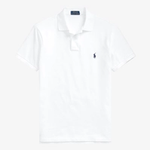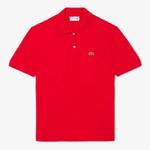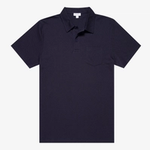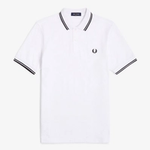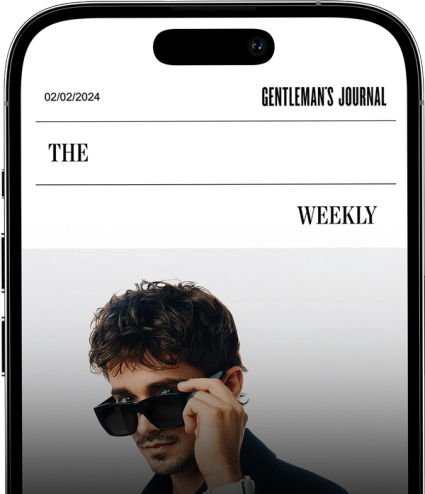

A celebration of the humble polo shirt
It's an item of clothing so familiar that it’s hard to imagine life without it
Words: Finlay Renwick
The polo shirt. That summer staple, a symbol of prep, privilege, counterculture, the odd sport or two, and something that’s just easy to wear when you’re on holiday. First appearing on the crushed brick clay courts of Roland Garros in 1920 (more on that later) before winding its way through every conceivable style and evolution of what we call ‘menswear’, the polo, along with the likes of the suit, Oxford shirt and chore jacket, is the type of ubiquitous item that can genuinely be called perennial.
As Ralph Lauren (more on him later, too) said about the item that helped to spawn a global lifestyle behemoth: "It was never about a shirt, but a way of living."
More than a century since its inception, the polo is still a favourite. Below we’ve charted the four brands and designers who have left the biggest mark on a real, genuine classic.
The Ralph Lauren polo
Where do you even start with this one? It’s not hyperbole to say that without Mr Lifshitz (as he was once known) we wouldn’t have the contemporary landscape of brands as extensions of a universe/lifestyle/entire reinterpretation of your personality. Lauren made it cool to be a cowboy, a sailor, a flaneur, an Ivy League professor, a rough and tumble (faux) blue-collar greaser, or a combination of them all. Born in the Bronx, Lauren started out making ties in a little room inside the Empire State Building, growing into an impresario who ingeniously made polo shirts a key part of both fashion and pop culture... for decades and decades.
Rappers love polo, private equity guys love polo, polo guys love polo — that’s the Midas touch in full effect. From Pharrell to Leonardo DiCaprio (you know that shot of him in The Wolf of Wall Street, a yuppie menace on the deck of a superyacht), the RL polo shirt is the classic standard-bearer of cool. As Lauren himself told Gentleman’s Journal... “I always had something inside of me I wanted to express, and over time I found different ways to say it — through the things that we wear, the things that we live with — a world of quality that is timeless and authentic.”
The Lacoste polo
The polo shirt as we know it wouldn’t even exist without a certain enterprising Frenchman. René Lacoste, a debonair Gallic tennis champion, had grown tired of the cloying outfits of the twenties: flannel trousers; v-neck jumpers; long-sleeve shirts. “Mon dieu! There must be another way,” we imagine he thought. In 1933 he put the finishing touches on a lightweight polo shirt in ‘petit piqué’ cotton, and the rest is history.
As well as being the inventor of the first polo shirt, Lacoste was also the first true sports brand to feature a logo on its clothing — an embroidered crocodile referencing its founder’s nickname. Now you can’t move without seeing scores of that little green croc, whether it’s through sepia-tinted photos of Clint Eastwood in sun-bleached turquoise; Nat King Cole in the studio, pressed polo tucked into billowing pleated trousers; or Novak Djokovic in pristine white at the All England Lawn Tennis Club. Lacoste, too, has high fashion credentials, with creative directors such as Louise Trotter (now helming Bottega Veneta) reinterpreting its bread and butter into a runway piece. If you’re talking about staying power, then Lacoste is the first and last name on the team sheet.
The Sunspel polo
A more understated entry into the polo shirt canon, Sunspel isn’t exactly known for heavy logos or a rainbow colour palette, but what it does possess is a heritage spanning 165 years, and an expertise when it comes to quality and cut.
Sunspel’s classic Riviera polo shirt was introduced in the 1950s. Peter Hill, the grandson of Sunspel founder Thomas Hill, wanted to create a more lightweight, leisurely iteration of the original sporting polo that he still found to be a little bit too cumbersome for a long weekend by the Cote d’Azur. The younger Hill returned to Nottingham and utilised the company’s disused lace-making machines to create a new cotton warp knit mesh. This lighter, more breathable approach was soon became a favourite of the likes of Paul Newman and Steve McQueen.
In more recent times, Sunspel is perhaps best known as providing the stylish polos for Daniel Craig’s era of 007. Bond wore Sunspel in Fleming’s original novels, which lead costume designer Lindy Hemming to reach out and commission a special edition that could handle the summer heat — and Craig’s reasonable biceps. They slimmed the fit across the chest and shortened the arms for added flattery. As Hemming said, “I thought that it would be a perfect collaboration of quality and Britishness to ask Sunspel to create all Bond’s T-shirts, polo shirts and underwear, which they duly did so excellently. He looks very sexy and happy in its clothing.”
The Fred Perry polo
Synonymous with counterculture and that nebulous quality of ‘Britishness’, Fred Perry is as English as a fried breakfast, a carpeted pub and getting rained on at the bus stop. The first Fred Perry polo shirt appeared in 1952 — a clean and simple all-white item with that famous laurel wreath embroidered on the chest. It soon shifted from a piece of tennis kit to a bona fide youth culture phenomenon, embraced by punks, suede heads, rude boys, mods, terrace casuals and hooligans, along with the rave set and, later on, what we know as Britpop and on to the first wave of indie. Working-class kids modified and adapted their Fred Perry polos to fit into various groups.
In his book Resistance Through Rituals: Youth Subcultures in Post-War Britain, the cultural historian John Clarke writes that style has a “multifunctional role. On one hand it is the embodiment of that subculture’s identity and the way it sees itself, while on the other it defines the boundaries of the group; who is in and who is out, who is with us and who is against us.”
While the original polo featured a solid colour collar, the introduction of the M12 polo, with its ‘twin tipping’ around the collar, is what led to the style breaking through in the sixties. The brand has since collaborated with the likes of Raf Simons and British designers such as Nicholas Daley and Craig Green, offering up a blank template on which they can blend nostalgia, energy and fresh ideas.
This article was taken from the summer 2025 issue of Gentleman's Journal, which you can read more about here.
Become a Gentleman’s Journal member. Find out more here.
